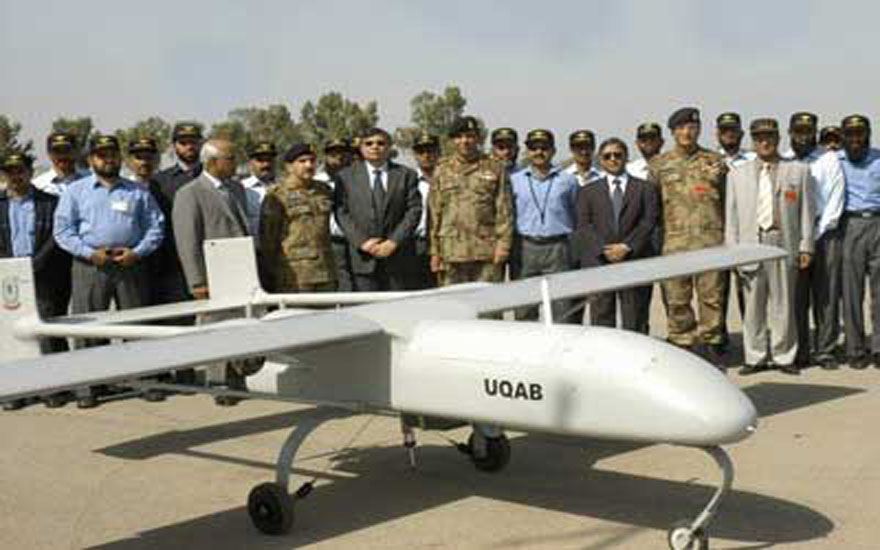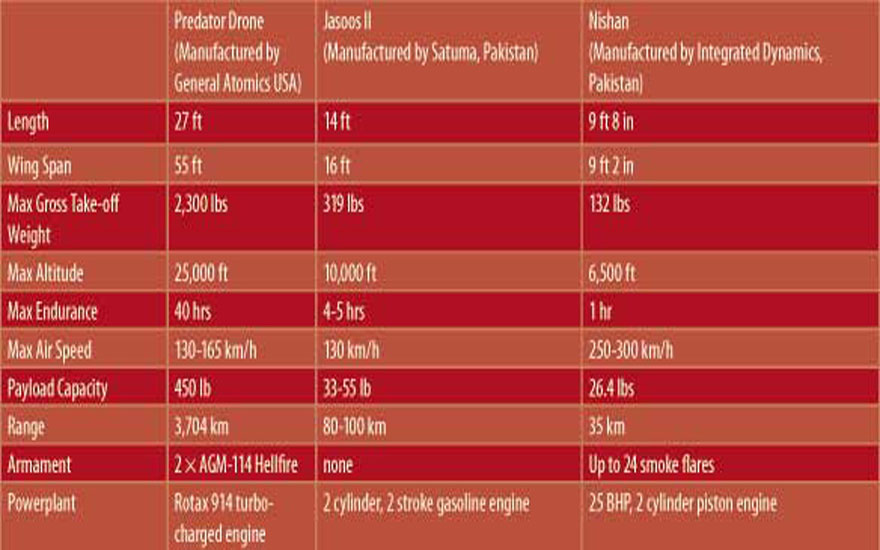Made in Pakistan
By Shahzeb Shaikha | Business | News & Politics | Technology | Published 15 years ago
It would come as a surprise to most Pakistanis that the country has an indigenous Unmanned Aerial Vehicle [UAV] industry. In fact, there are three private entities — East West Infiniti [EWI], Integrated Dynamics [ID] and Surveillance and Target Unmanned Aircraft [Satuma] — involved in the manufacturing of UAVs in Pakistan. In addition, three government enterprises, the Pakistan Aeronautical Complex [PAC], the Air Weapons Complex [AWC], and the National Development Complex [NDC] also produce UAVs.
The Pakistan government has repeatedly requested the US to send them drone technology, a request which, according to defense analyst Ayesha Siddiqa, has been persistently denied because “we always leak technology.” But what if Pakistan develops its own drones with a missile delivery system matching the American Predator?
At this point, the question of ‘what if’ doesn’t exist because Pakistan already possesses the capability to develop its own unmanned vehicles. But there is a big difference between producing unarmed UAVs, which Pakistan currently does, and the armed Predator drones which the US has been using in FATA.
Can Pakistan come up with a UAV carrying weapons?
Dr Hammad Bin Khaleeq, Satuma’s director in charge of mechanical design and manufacturing, Dr Haroon Javed Qureshi of EWI, and Raja Sabri Khan, CEO of Integrated Dynamics, all concur.
“It is possible,” Khaleeq tells Newsline. “It is not something beyond our capability. We only need to have support — financial support as well as time. These things don’t develop overnight.” He maintains that there have been huge amounts of investment from the government for the purpose of developing drones but state entities have failed to deliver the desired product. “Acquiring and integrating a weapon in drones is advanced and difficult. But it’s not out of our reach. If the government wants, the efforts can be put in.”
Qureshi confidently explains that if the drone project is headed solely by private enterprises, “I can assure you that my company, or, for that matter, Raja Sabri Khan’s Integrated Dynamics, or Satuma, can perhaps do it in three years. One has to keep in mind that all three companies have been in this particular business for 15 years and are well aware of the ground realities.”
However, Khan is sceptical about the three-year estimate. “I worked for Suparco from 1987 to 1997, before I started my own company. Right now, the only constraint in Pakistan developing a predator type drone is money,” Khan says. He also maintains that state enterprises lack will and passion, and agrees with Qureshi’s stance on the government backing commercial firms to develop such technology. Khan reveals that a minimum investment of $50 million would be required to initiate a drone project along the lines of the Predator, but it could take as long as eight years.
According to the three private enterprises the drone technology in Pakistan is nowhere near the American Predator. The Predator carries a Hellfire missile that Pakistan does not have. Instead, Pakistan has the Baktarshikan and the Tow anti-tank missile, which can strike as far as 3,000 yards. The maximum payload weight of the Tow missile is 100lb. The main difference between the Predator and Pakistani-manufactured drones is the wing load capability and the engine size. The Predator can carry far more payload weight [450lb] and can fly more than 20 hours, covering a distance of 3,700km. The missile capability depends on how much load the wing can carry. The current technology in Pakistan limits the companies in terms of how much load per square foot they can put on the wing.
“There is a thought process along these lines in Pakistan, but, as far as real work is concerned, nothing is being done. Several of the UAV programmes that are now being carried out will have the capability of carrying at least 150lb.” Khan goes on to emphasise that his company is not providing Americans with the drones being used in FATA, a common misconception.
The Predator (MQ-1) and Reaper (MQ-9) cost approximately $4.5 and $10.5 million, respectively. Qureshi claims: “We can develop a drone in half a million or a million dollars, not more. And it would be cheaper for us to operate the drone any day.”
The operating cost for a drone is broken down into three elements: the actual weapon, the human costs and the engineering resources — which keep the aircraft flying and operational, both in the field and in the workshops — including their refurbishment and upgrading, and the people who are actually flying in the field. Pakistan’s human resources costs are at least 10 times cheaper than those in the US.

Homegrown: General Kayani with one of Pakistan’s indigenously produced UAVs.
Qureshi expresses his discontent with the military establishment and its enterprises heading the drone programme, saying that there is no drive and vision in these organisations. According to him, all state programmes involving drone manufacturing are headed by brigadiers. “They are all marking their time. Their motive is to do something that will result in their promotions. Soldiers just want another badge on their shoulders.” A regular speaker at military platforms, he doesn’t mince his words. “You [military personnel] want development in military technology, so remember that there is no on-and-off button in this process,” he tells them to their faces. “This project should have continuity in research and development. The best you can do is to leave us alone. Let us develop it ourselves. Let us operate like a commercial entity.”
The Predator, the Reaper and all related programmes in the world were privately driven innovations, claims Qureshi. “None of them are state-established. They [the companies] come up with a vision and present it to the state which says, ‘Very well, how much would it cost to develop this product?’ Whatever amount it is, the state gets that amount sanctioned and they tell the company to put up matching funds. Suppose the total developing cost is $50 million, we [the company] put up 15% and they [the government] give us 85%. These are the yardsticks one should consider. This project would be evaluated after two to three years. If you’re not meeting the yardsticks, the state pulls the plug on you [the business].”
One could sense the anger in him. He mentions a recent decision by the Pakistani military establishment that he considers a blunder. In 2006, the army bought 28 UAVs from EMT, a German manufacturer, at a cost of $24 million, and the Pak Air Force bought 24 Italian Galalio Falco’s — medium-altitude endurance tactical UAVs. Qureshi says that the same kind of UAVs could have been delivered for $4 million from within Pakistan.
The civilian government might still be unaware of Pakistan’s home-grown drone manufacturing capability and industry. Both Qureshi and Khaleeq claim that they have not been approached by the civilian leadership to develop drones with missile-carrying capability.
“I don’t know if they are aware of our existence, and we don’t care if they do or if they don’t. We are a private company and we haven’t approached the political leadership. We don’t interact with politicians,” Khaleeq says.
When asked if President Zardari is aware of this, Qureshi argues that he doesn’t know if the president knows or not. “Zardari himself is standing on one foot. But if the leadership commits to this project, we can have a drone carrying weapons, made and operated in Pakistan.” Khan tells me that due to a lack of financial capital, his company is not moving in the direction of developing anything of the sort. “We need the backing of the government,” he urges.
Currently, Pakistani-manufactured drones are closer to the American Shadow drone programme. Shadow 200 is being used by the US Marines in Afghanistan and Iraq. Shadow has small experimental delivery systems and relatively less endurance and range. Pakistani manufacturers have not copied UAV designs; they have been successful in developing their own UAV models. In addition, there is no doubt that Pakistan can develop its own UAVs because commercial companies have a proven track record.

The specs: Two Pakistan-manufactured UAVs versus the US Predator drone. Compiled by Shahzeb Shaikha.
Drones were first produced in 1983 by the Malir Air Defence School in Karachi. Since then, others have gotten into the act. EWI, established in 1983, was approached by Suparco in 1993 to develop a UAV. Qureshi, EWI’s founder and managing director, informs Newsline that the Pakistani establishment had approached him with a half-hearted effort to develop such a technology.
“The chairman of Suparco told us in 1993 to develop a UAV in three months. We declined, as it was out of the question to develop something of the sort in such a short amount of time. Then they came back in 1995 and gave us a one-year period,” Qureshi recalls. “A while later, they ran out of money.”
Coming from a military family, Qureshi has a fair idea of the ins and outs of the military. His father was a brigadier in the Pakistan Army. Qureshi, on the other hand, was in pursuit of bridging the gap between the East and the West in terms of technological advancement and exchange of information between people from both regions of the world. This obsession was what initially pushed him to found East West Bridge, now known as East West Infiniti.
According to Qureshi, the US military itself is not yet trained to operate UAVs. The person who operates the Predator [being used in Afghanistan and bordering Pakistan] is the contractor who supplies it. The functions of taking off, landing and flying the drone are carried out by the engineering element. Only the weaponry is handled by people in uniform. Essentially, the company that manufactures the drones has the joystick, and the person in uniform presses a button to release the missile to strike the target.
EWI initiated its serious UAV business model in 1995. Qureshi outlines their objective, to develop an unmanned aircraft covering a distance of 100km at 150 km/h, with an endurance time of four to five hours. For a UAV to be successful, he explains, one needs to fly it as slowly as possible, to get good imagery from the sky.
“We collaborated with the newly-founded company Satuma in 1995, and formed Satuma Infiniti Technology,” says Qureshi. “We developed two UAV models and we had a fairly decent device. Also, every senior military officer was aware of our products.”
The ferry range of EWI’s UAV was around 400km. “We gave our last demo in 1999 in Islamabad, two months before the military coup took place,” he says.
In 2001, EWI changed course and abandoned developing drones because it was too costly. According to Qureshi, it was costing his company around Rs 1.5 million a month. Key costs were the senior employees — PhDs and autopilot experts. Currently, EWI develops micro-drones and unmanned airships. Hardly two feet in size and electric-powered, the micro drone is like a bird-size spy plane. The unmanned airships fly at a ceiling of 3,000 feet with an autopilot mechanism, and can carry a payload of 50kg. The sole buyer of this spy plane is Pakistan’s military.


